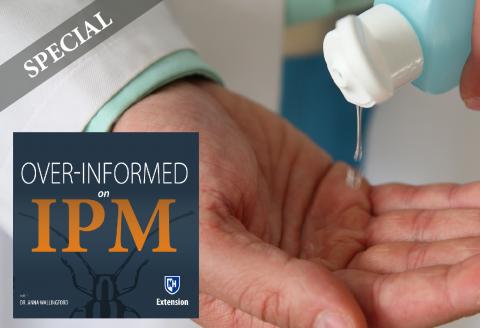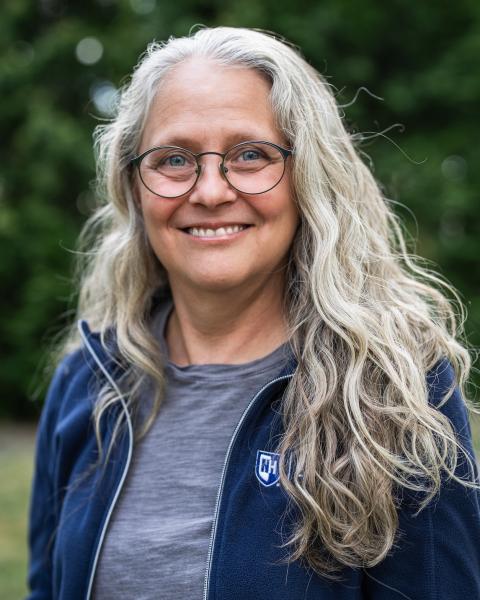Over-informed on IPM - SPECIAL EDITION - Sanitizers & Disinfectants for Managing COVID-19

List N Tool: COVID-19 Disinfectants - U.S. EPA
Read Mary's blog posts Part One and Part Two
Transcript
We are taking a break from the usual format this week to bring you a special episode – an interview from my colleagues in UNH Extension’s Food Safety team who have been hard at work putting together information on best practices for those of you using surface cleaners to prevent the spread of COVID-19 in your farm business.
What does food safety have to do with COVID you might ask? And what does COVID have to do with IPM you might wonder?
Best practices in Food Safety protect us from unwanted microbial organisms in our food that might make us sick. So there is much to learn from food safety experts about how to use sanitizers and disinfectants to protect us from picking up coronavirus where we live, work and learn.
Also, sanitizers and disinfectants are chemicals meant to kill microbial pests so they are pesticides, with EPA registrations and label restrictions and everything. This holds true for products registered for use in the farm as well as those registered for use in the home.
So, while there is great benefit to using cleaning products to prevent the spread of COVID-19, these products are not completely without harm. You should know which products work to eliminate virus from your surfaces and you should know how to use them properly. But I will leave that to the experts here, Heather Bryant interviews Mary Choate …
Heather: So Mary can you set the stage by telling what causes COVID-19 and how it is spread?
Mary: SARS-CoV-2, the virus that causes COVID-19. COVID-19 a shorthand for “coronavirus disease 2019.” This is thought to spread mainly from person-to-person, through respiratory droplets produced when an infected person coughs or sneezes. These droplets can land in the mouths or noses of people who are nearby or possibly be inhaled into the lungs.
It may be possible that a person can get COVID-19 by touching a surface or object that has SARS-CoV-2 on it and then touching their own mouth, nose, or possibly their eyes, but this is not thought to be the primary way the virus spreads. The main way is from person-to-person respiratory droplets.
Heather: And can you tell us more specifically what prompted you to write this blog series?
Mary: There were several reasons that seemed to happen in quick succession that really needed to be clarified for folks. The national poison control center reported a jump in poisonings related to disinfectant use starting around COVID times, suggesting that people have been using these products the wrong way. Also, in asking different folks how they measure sanitizer, they said they kind of use the glug glug method. That’s really the wrong way to measure sanitizer and disinfectant. The third thing was really all of the information on the internet that seemed to be confusing the difference between sanitizing and disinfecting and they are different, in important ways, especially regarding food contact surfaces.
Heather: Well that sounds important! Can you tell us how they are different?
Mary: One way they are the same is that they both have to be used on a clean surface. You can not sanitize a surface that’s covered with mud or dirt or food. The first thing to do is clean with detergent or soap and water and rinse off the surface you want to sanitize or disinfect.
But now, the difference. Sanitizing lowers the number of germs on a clean surface to a safe level determined by a public health standard or food health requirements. Sanitizers you’re going to use for food preparation surfaces are formulated in a way that you can use them without rinsing. You sanitize then you let that surface air dry.
Disinfectants are different in that they are normally stronger but they also leave a residue. That would be a germ-killing residue, but also a residue that could contaminate food if put down on that treated surface. If you have instance where a person is infected with COVID-19 and sneezes on a food prep surface – What do you do? – Well you would have to clean and disinfect that surface, rinse it, then sanitize it.
The other thing that’s important, both with sanitizers and disinfectants. You have to read the label and make sure they remain wet for contact time that’s required by the label. If you’re using a wipe and the label says the surface has to stay wet for 10 seconds or a minute for that compound, you may have to use more wipes to keep that surface wet for the amount of time stated on the label.
Heather: So that sounds like really important information. Can I just sum this up and you can tell me if I’ve got it right? A sanitizer’s purpose is not to kill everything but can bring the level down to something that’s relatively safe. And most of the time, when you use a sanitizer, you put it down and you don’t wipe it off, you just let it dry. A disinfectant on the other hand is usually a stronger chemical, meant to kill all of the microbes, which might become a contaminant itself. So you’d want to rinse those off before using that surface for food.
Mary: Right, but there’s not a reason to use a disinfectant on a food surface unless it’s been contaminated by an ill person. Use sanitizers on food surfaces and disinfectants on high touch surfaces, like doorknobs, steering wheels, point of sale things. Things a lot of people are touching.
Heather: What negative impacts might we expect if I were to use cleaning products, sanitizers and disinfectants improperly?
Mary: Well this happens a lot. If folks think well this amount is how much I’m supposed to use so double or triple is better, that is a really good way to cause problems. For example, harmful fumes can be produced when you’re using too much of a product. It can harm your lungs. It can corrode materials, metal, plastic. I had one farmer ask what can I used beside chlorine to clean my plastic coolers? They really got wrecked after one season. I asked how much bleach are you using in your solution. He kind of embarrassedly admitted he didn’t know. He was glug glug glugging it. That’s one of my best arguments for measuring and using materials according to the label.
Another thing that can cause some trouble with your health is to combine sanitizers that aren’t intended to be combined. A lot of smart people have done this. Some combinations produce poisonous gases that can harm your lungs and send you to the emergency room.
So the moral of the story here is to ready the label and follow it exactly.
Heather: So next I’m going to imagine a couple scenarios and ask you some questions about this. First. I have no reason to believe any of my staff have COVID-19 what if any additional steps would you have me add to my usual process of cleaning and sanitizing as necessary?
Mary: All right, so if no one is ill, the USDA guidance recommends that the same sanitary procedures that establishments are already following to protect food safety will also help prevent the spread of respiratory illnesses like COVID-19.
For farms and farm stands, this would mean continuing to follow the food safety and hygiene procedures already in place for keeping produce hygienic and safe. Farm food safety plans may include washing, rinsing, and sanitizing food contact surfaces and tools such as knives before and after use.
For food businesses such as restaurants and food processors this would mean following the Food Code regulations and Sanitation Standard Operating Procedures (Sanitation SOP) that they have developed and implemented to prevent contamination or adulteration of product.
Heather: Ok. Now lets say I have a farm stand that is open to the public but I have no specific information that any of my staff or customers has COVID-19 what steps would you advise me to take regarding cleaning the farm stand?
Again, the same sanitary procedures you are already doing will be adequate for keeping the food safe.
Additional cleaning and disinfecting steps will reduce the already low risk for the spread via contaminated surfaces even more. These strategies also reduce the potential for spreading familiar bad bugs that cause foodborne illness such as E. coli, Salmonella, hepatitis A and norovirus.
CDC recommends: At least once a day cleaning and disinfecting of surfaces frequently touched by multiple people: door handles, desks, phones, light switches, and faucets, baskets, steering wheels, POS equipment, etc.
More often than this is also acceptable and may be welcomed by customers.
Heather: That’s an important point because our customers are just as concerned as we are. Do doing the right thing and letting your customers know you’re doing the right thing are both important now. One more scenario for you. If I were to learn that one of my staff members or one of my customers tested positive for COVID-19, has symptoms of COVID-19, what additional steps would you recommend?
Mary: Ok if a member of staff is showing
What additional cleaning would you advise me to do if I do learn that a staff member or customer has tested positive for or is showing signs of COVID-19?
You would want to clean and disinfect areas and items the worker or customer may have contaminated.
CDC recommendations include these cleaning and disinfection steps:
If surfaces are dirty, they should be cleaned using a detergent or soap and water prior to disinfection.
If a surface is not visibly dirty, you can clean it with an EPA-registered product that both cleans (removes germs) and disinfects (kills germs) instead. Be sure to read the label directions carefully, as there may be a separate procedure for using the product as a cleaner or as a disinfectant.
For disinfection, most common EPA-registered disinfectants should be effective, paying special attention to whether the products are recommended for the kind of surfaces you are using the disinfectant on.
If the ill person contaminated food contact surfaces, equipment or utensils, those surfaces should be disinfected and then rinsed and sanitized before being used for food preparation.
Heather: OK. Where can I find a list of EPA-approved products?
Mary: For that list you would want to search online for List N: Disinfectants for Use Against SARS-CoV-2 (COVID-19)
Heather: And do you have any final recommendations for our listeners?
Mary: Read the Label and follow the instructions there. Pay special attention to the amount recommended, how long it needs to contact the surface you are working on. It’s about applying what you already know from using pesticides.
Heather: That’s great and I want to emphasis a point you’ve made. A lot of our pesticides – a sanitizer or a disinfectant – can often be used in multiple scenarios. So it’s important to read that part of the label referring to the use you are mixing and preparing it for.
Related Resource(s)

